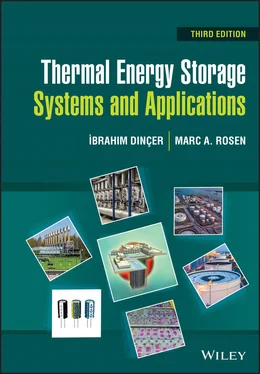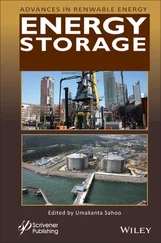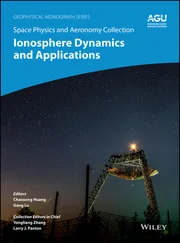Exact solutions to the nonlinear Navier–Stokes equations are limited to a few cases, particularly for steady, uniform flows (either two‐dimensional or with radial symmetry) or for flows with simple geometries. However, approximate solutions may be undertaken for other one‐dimensional simple flow cases which require only the momentum and continuity equations in the flow direction for the solution of the flow field. Here, we present a few cases: uniform flow between parallel plates, uniform free surface flow down a plate, and uniform flow in a circular tube.
Uniform Flow Between Parallel Plates
Consider a two‐dimensional uniform, steady flow between parallel plates, which extend infinitely in the z direction, as shown in Figure 1.10. We also consider the plates to be oriented at an angle θ to the horizontal plane, which results in a body force per unit mass as the gravitational term g sin θ . Therefore, the pressure gradient is specified as (𝜕 p /𝜕 y ) = constant = P *. After making necessary simplifications and integrations, we find that the total flow rate per unit width and the velocity profile as follows:
(1.68) 
(1.69) 
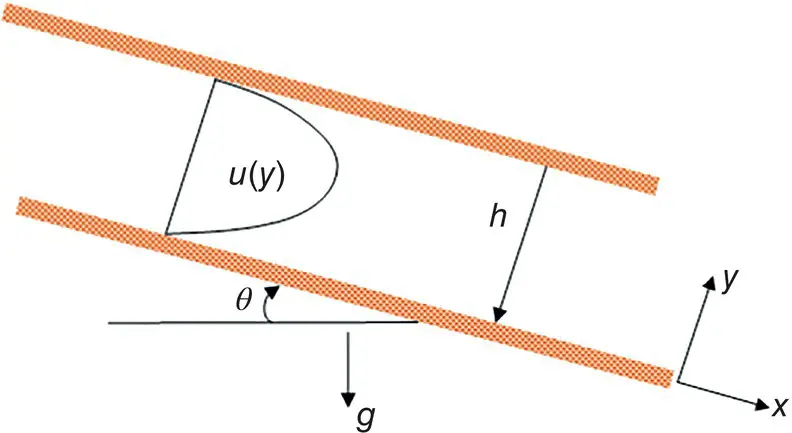
Figure 1.10 Uniform flow between two stationary parallel plates.
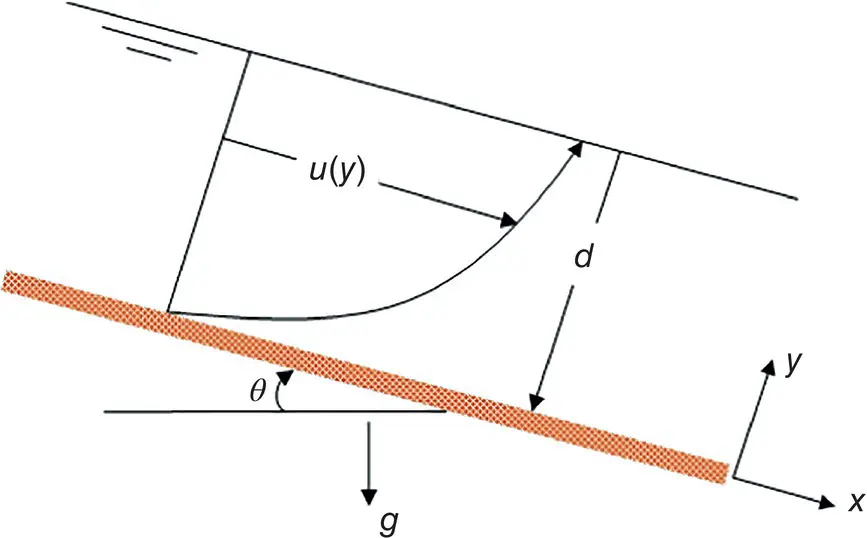
Figure 1.11 Uniform flow down a plate.
If the plates are horizontally located (i.e. sin θ = 0), the above equations reduce to
(1.70) 
(1.71) 
Uniform Free Surface Flow Down a Plate
This case is, by nature, similar to the previous case, except that the upper plate has been removed, as shown in Figure 1.11. The boundary condition at the lower boundary is the same no‐slip boundary condition as before, so that the velocity is zero. However, the boundary condition at the free surface can no longer be specified as no‐slip. The total flow rate per unit width becomes
(1.72) 
while the flow velocity is
(1.73) 
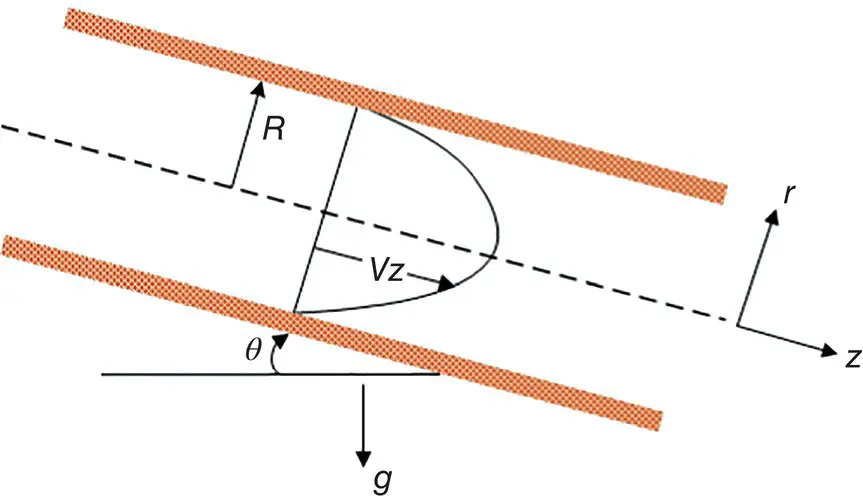
Figure 1.12 Uniform flow in a pipe.
Furthermore, the average velocity can be obtained by dividing the discharge by the flow area or depth as follows:
(1.74) 
Uniform Flow in a Circular Tube
This case concerns uniform fluid flow in a pipe of radius R , as shown in Figure 1.12, which is the most common example in practical applications associated with pipe flows. Despite having the flow field as three‐dimensional, the assumption of radial symmetry makes the problem two‐dimensional. Therefore, the parabolic velocity distribution with the maximum velocity at the center of the pipe can be found as follows:
(1.75) 
which is known as the Hagen–Poiseuille equation. The total volumetric flow rate can be calculated if the pressure gradient, along with other flow conditions, is specified and vice versa, as follows:
(1.76) 
If the pipe is horizontally located (i.e. sin θ = 0), the above equations result in
(1.77) 
(1.78) 
If there is an equivalence between fluid and surface velocities at the interface between a fluid and a surface, it is called a “no‐slip” condition, which is entirely associated with viscous effects, as mentioned earlier. In practice, any real fluid flow shows a region of retarded flow near a boundary in which the velocity relative to the boundary varies from zero at the boundary to a value that may be estimated by the potential‐flow solution some distance away. This region of retarded flow is known as the boundary layer , which was first introduced by Prandtl in 1904. His hypothesis of a boundary layer was arrived at by experimental observations of the flow past solid surfaces.

Figure 1.13 Development of boundary layer in a viscous flow along a plate.
Of course, the boundary layer can be taken as the region of the fluid that is close to the surface immersed in the flowing fluid, and the boundary layer development takes place in both internal and external flows. In internal flows, it occurs until the entire fluid is encompassed, as in pipe flow and open‐channel flow. Boundary layer development is important for external flows, which exhibit a continued growth due to the absence of a confining boundary, such as a flow along a flat plate. It is, therefore, important to assume that the velocity at some distance from the boundary is unaffected by the presence of the boundary, referring to the free‐stream velocity u s.
We now consider a uniform flow of incompressible fluid at a free‐stream velocity approaching the plate, as shown in Figure 1.13. Since the plate is stationary with respect to the earth, when the fluid is in contact with the plate surface, it has zero velocity (i.e. the “no‐slip” condition). Later, the boundary layer thickens in the direction of flow, and a velocity gradient at a distance δ over an increasingly greater distance normal to the plate takes place between the fluid in the free stream and the plate surface. The rate of change of velocity determines the velocity gradient at the surface as well as the shear stresses. The shear stress for the laminar boundary layer becomes
Читать дальше
